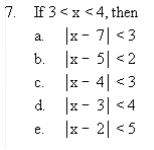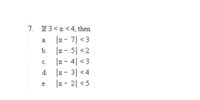
My work: ( I solved all the options through the absolute rule:if |u| <a,a> 0 then -a<u<a
|x-7|<3
-3<x-7<3
x-7>-3 and x-7<3
x>4
x<10
solved for x interval: 4<x<10
|x-5|<2
-2<x-5<2
x-5>-2 and x-5<2
x>3
x<7
solved for x interval: 3<x<7
|x-4|<3
-3<x-4<3
x-4>-3 and x-4<3
x>1
x<7
solved for x interval: 1<x<7
|x-3|<4
-4<x-3<4
x-3>-4 and x-3<4
x>-1
x<7
solved for x interval: -1<x<7
|x-2|<5
-5<x-2<5
x-2>-5 and x-2<5
x>-3
x<7
solved for x interval: -3<x<7
But my results don't match up with 3<x<4, I feel like I made an error somehow, or that I am not understanding the concept of the problem. Is there any step that needs to be done after solving for the x interval?
NOTE:
The answer key says it's supposed to be b, if that helps.

